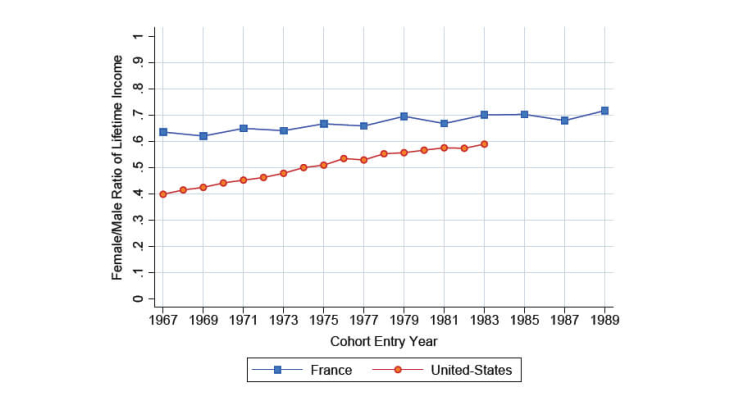Figures on the gender pay gap regularly hit the headlines and often play a key role in promoting the principle of equal pay for equal work. The academic literature has focused extensively on both the narrowing and the persistence of the cross-sectional gender pay gap in developed countries. However, such point-in-time measures of inequality present limitations. In particular, they do not reflect income mobility over the life-cycle and are affected by transitory income shocks. Moreover, as Goldin et al. (2017) notes, “the gender earnings gap is a shifting statistic” over the life-cycle. Therefore, a broader perspective based on lifetime earnings (LTE), i.e., examining the earnings of several cohorts over their life cycle, can significantly enrich the analysis of the long-term dynamics of the gender earnings gap.
In this paper, we analyse the dynamics and drivers of the decline in the gender gap in lifetime earnings for cohorts born after World War II in a large European country, France. The analysis of the dynamics and distribution of lifetime earnings has been limited by data availability, and most recent contributions have focused on the US. However, based on cross-sectional data, it is well documented that both the evolution of average earnings and their dispersion have followed different paths in Western European economies compared to the US. First, the cross-sectional gender pay gap in the US is larger than in other countries, including France. Second, over the second half of the 20th century, the cross-sectional gender pay gap fell more in the United States than in Western European countries. This paper is the first to assess whether these point-in-time gender differences accurately reflect life-cycle differences, offering a novel perspective on the long-term trends that have shaped gender inequality across different contexts and cohorts.
Our analysis relies on a long administrative panel dataset that combines firm-level and census information. First, we compute the gender gap in lifetime earnings and its distribution, for a large number of cohorts in France, and provide a direct comparison with the US, based on Guvenen et al. (2022). Following their approach, we measure lifetime earnings over 31 (potential) working years, from age 25 to 55. Our core sample consists hence of the cohorts born between 1942 and 1964, who turned 25 years old between 1967 and 1989. Second, using the richness of our administrative data for France, we assess the role of various determinants (working time, education, family composition, and location) in explaining the dynamics of the gender gap in lifetime earnings since the 1960s.
We start by documenting, for the first time, the evolution of the gender gap in lifetime earnings in France, and find that the level, trends (Figure 1), and distribution of gender differences in lifetime earnings contrast sharply with those observed in the US, and that these differences are more marked than when we compare cross-sectional gender gaps. Drawing on the existing literature that highlights cross-country differences in the cross-sectional gender gap, we synthesize key findings and examine the institutional factors that may drive these disparities. We explore in particular the role of the minimum wage and collective bargaining, as well as the main cross-country differences in labor market participation.
Second, we show that this reflects a specific pattern in which both men and women experienced earnings gains over the whole distribution (with the exception of the very top), in contrast with the US, where the same cohorts of men experienced earnings losses in the three bottom quartiles of the distribution.
We then decompose the changing role of various factors (e.g., working (part) time, education, occupation, geographical location) in shaping the evolution of the gender lifetime earning gap in France. The contribution of unobserved factors decreases across cohorts and increases along the distribution, remaining larger at the top, consistent with a glass ceiling effect. Meanwhile, the impact of observed factors rises. The most important effect is due to working time and, more specifically, to the decline in the years worked full time by women, which slowed down the convergence across genders. Notably, the increase in years worked by women over the course of their careers across cohorts was exclusively in part-time employment. Education also contributes to explaining the gender gap in lifetime earnings, albeit to a lesser extent. We find a decrease in the returns to all educational attainments other than a Master’s degree (and above) for both men and women, while the gender gap in returns has narrowed, though remains substantial.
Keywords: Lifetime Earnings, Inequality, Gender Earnings Gaps
Codes JEL : J16, J31, J62
